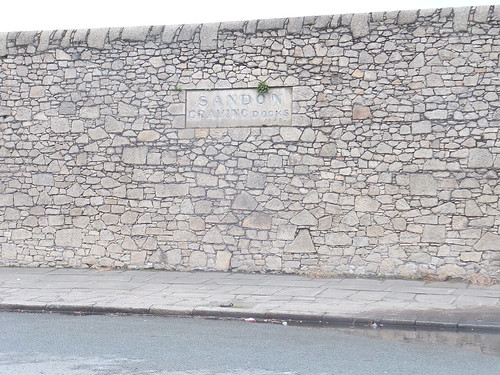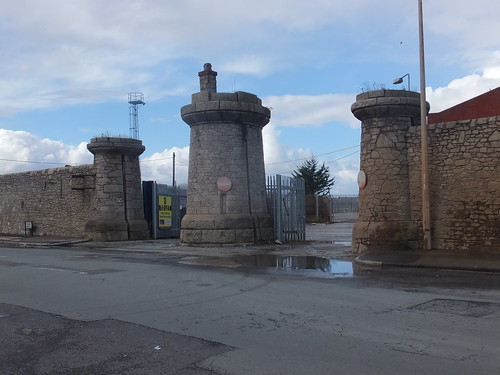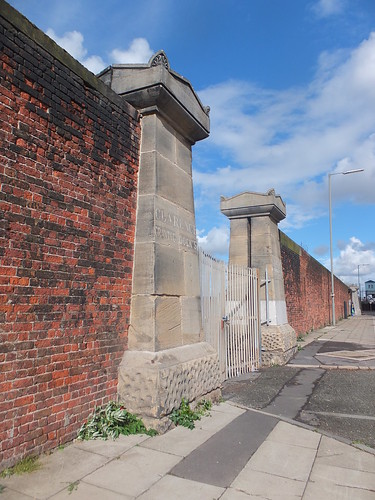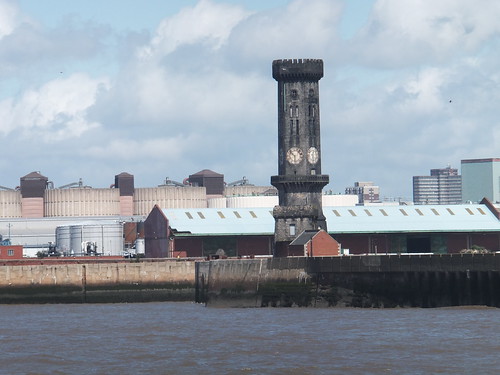I've always found Liverpool a special place. In 2009, I wrote my first post about the City called simply Liverpool. Since then, I've added a number of posts with a Liverpool theme. I summarised my posts up to June 2014 in the post Liverpool (again). Liverpool's location on the west coast of England, facing Ireland and the New World, encouraged its growth as a major seaport. By 1927 the dock system extended for over 6 miles along the east side of the estuary of the River Mersey. The panorama of the docks below in the 1950s was included in the post The Liverpool Overhead Railway (where there is a larger version).

Notes on the History of Liverpool Docks
In the 18th century, the Old Dock (subsequently filled in), Canning Dock, Salthouse Dock, Georges Dock Dukes Dock, Kings Dock and Queens Dock were built, all upstream (south) of the present Pierhead. In 1810 John Foster Senior added Princes Dock. In 1824 the remarkable Jesse Hartley (1780 - 1860) became Dock Engineer and, by 1860, had increased the size of Liverpool's docks from 46 acres to 212 acres. All the old docks were modernised and he was responsible for the design and execution of numerous new docks both to the north (Clarence Dock, Waterloo Dock, Trafalgar Dock, Stanley Dock, Collingwood Dock, Nelson Dock, Bramley-Moore Dock, Salisbury Dock, Wellington Dock, Sandon Dock, Huskisson Dock, Canada Dock) and to the south (Brunswick Dock, Coburg Dock, Albert Dock, Toxteth Dock, Wapping Dock)
Hartley's background was as a stonemason and the quality of the work he supervised was so good that it can be admired even today. He had a fondness for so-called 'Cyclopean' masonry using irregularly-shaped stones carefully fitted together. In constructing quay walls, huge stones might be used but a similar style with smaller stones was also used extensively.
 Enclosing wall for Sandon Graving Docks, built 1848, featuring Jesse Hartley's 'Cyclopean' masonry.
Enclosing wall for Sandon Graving Docks, built 1848, featuring Jesse Hartley's 'Cyclopean' masonry.
When Hartley used 'worked' stone, the accuracy he demanded was amazing. His architectural style is sometimes called 'eclectic' but I'm tempted to call it 'eccentric'. He mixed styles and materials in a flamboyant manner, but work was always carried out to the highest quality.
Hartley was an innovator in dock design. He constructed huge locks to separate the river from groups of docks, allowing the water level to be kept constant in the docks to facilitate loading and unloading of ships. But the locks allowed ships to enter or leave the docks at any state of the tide.
 A Lock Keeper's Office by Jesse Hartley, illustrating his attention to detail and build quality.
A Lock Keeper's Office by Jesse Hartley, illustrating his attention to detail and build quality.
Jesse Hartley also pioneered the concept of Enclosed Docks. By providing substantial, tall dock walls with access to the docks only through manned gates, theft was significantly reduced.
 Jesse Hartley Dock Wall in stone with In-Out gates flanked by round turret-like stone pillars (slotted for sliding gates) with matching stone Gatekeeper's Office (incorporating a chimney).
Jesse Hartley Dock Wall in stone with In-Out gates flanked by round turret-like stone pillars (slotted for sliding gates) with matching stone Gatekeeper's Office (incorporating a chimney).

Jesse Hartley Dock Wall in brick with gateway flanked by stone pillars (Clarence Graving Docks).
An example of Jesse Hartley's architectural range is the 6-sided clock tower at the entrance to Salisbury Dock, completed in 1848. It's called officially Victoria Tower and is described on Wikipedia here. Listed Grade II it awaits the refurbishment promised by Peel Ports. There's further information on the Tower here.
 Victoria Tower from the river.
Victoria Tower from the river.
The prolific Jesse Hartley was also the Dock Engineer for Birkenhead's docks. There's a brief post on a walk around Birkenhead's docks here.
Jesse Hartley died in 1860 and his immediate successor was his son, John Hartley. Over the next 40 years, Liverpool Docks continued to expand both to the north (Brocklebank Dock, Langton Dock, Alexandra Dock, Hornby Dock) and the south (Herculaneum Dock, Harrington Dock). In 1913, Gladstone Graving Dock (a Dry Dock) was opened, followed by Gladstone Dock in 1927.
This represented the zenith of dock development in Liverpool. In the 1950s, the now-familiar Shipping Container was introduced. Containerisation reduced the need for traditional docks like Liverpool. In 1972, a new container dock was built to the north of Gladstone Dock, Seaforth Dock (sometimes called 'Royal Seaforth Dock'). Some of the old docks have been filled-in to permit new developments but most of the quays and enclosed areas of water remain but, for the most part, much less used.
Liverpool Docks were operated by the Mersey Docks and Harbour Board for a long period and there's a brief post here. Today, a reduced set of docks is operated by the Mersey Docks and Harbour Company, part of Peel Ports.
The Peel Ports website on Liverpool is here. The emphasis now is on the container post at Seaforth, which rendered many of the earlier docks redundant. Peel Ports are also completing a new deepwater container port called 'Liverpool2', due to open in 2015, which they say will handle "two 380m mega post-panamax vessels simultaneously". There's more information here and an excellent explanation of the terms 'Panamax' and 'Post-Panamax' in Wikipedia here.
I consider myself fortunate that I saw Liverpool Docks before the Containerisation Revolution brought major changes to its role.
Related articles on other sites
Jesse Hartley (Wikipedia).
Port of Liverpool (Wikipedia).
List of Liverpool Docks (Wikipedia).
Liverpool Docks (Victoria County History).
Mersey Docks 1949.
Seaforth Dock (Wikipedia).
Peel Ports, Liverpool.
Peel Ports, Liverpool2
Related posts on this site
Liverpool.
Liverpool (again).
The Liverpool Overhead Railway.
Birkenhead and New Brighton by train (Part 2) (On foot around Birkenhead's Docks).
The Mersey Docks and Harbour Board.
On foot around Liverpool Docks.
Books
[1] 'Jesse Hartley - Dock Engineer to the Port of Liverpool 1824-60' by Nancy Ritchie-Noakes, published by National Museums and Galleries on Merseyside (ISBN 0 906367 05 0).
[2] 'L.N.W.R. and the M.D.& H.B. - The History of the Dock Lines from the Records' by J. C. James, Limited Edition published c1981.
[3] 'Prince's Dock - A Magnificent Monument of Mural Art' by Adrian Jarvis published 1991 by Merseyside Port Folios (ISBN 0 9516129 0 5).
[4] 'Liverpool and its Canal' by Mike Clarke and Allison Hewitt published 1992 by Merseyside Port Folios (ISBN 0 9516129 3 X).
[5] 'An Illustrated History of Liverpool's Railways' by Paul Anderson, published Irwell Press (ISBN 1-871608-68-6).
My Pictures
Liverpool Docks.
Liverpool.
